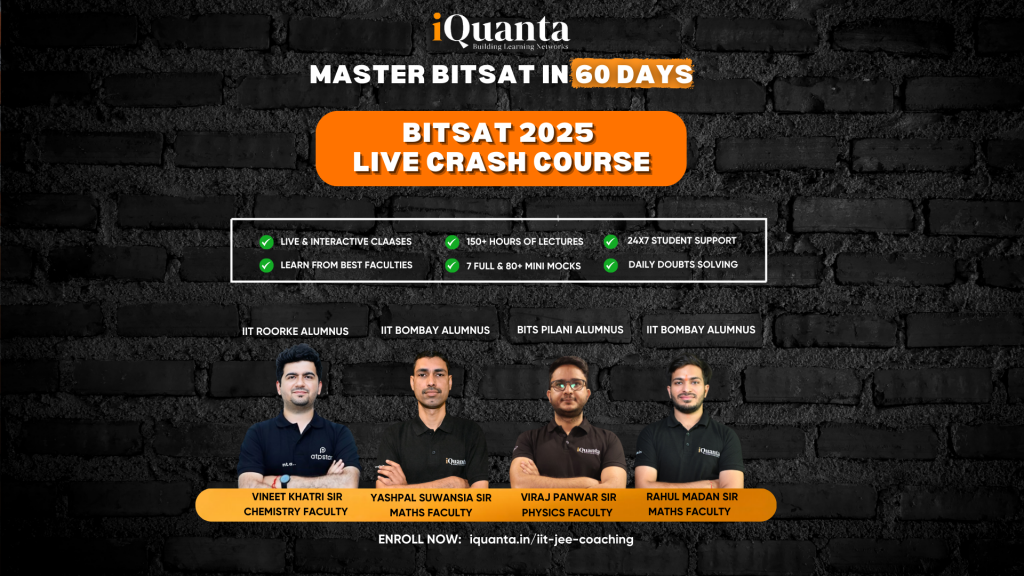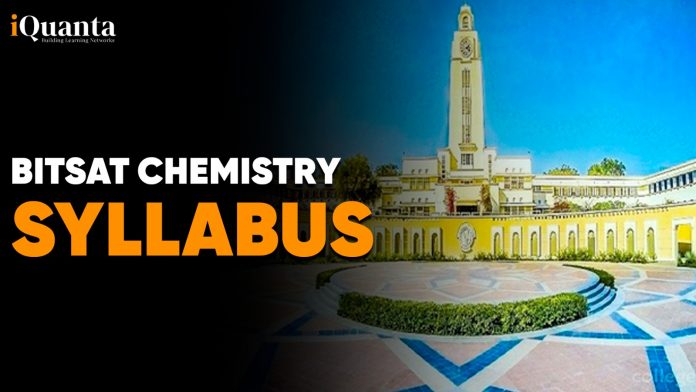The BITSAT 2025 syllabus has been released online at bitsadmission.com, including detailed topics for chemistry. BITSAT Chemistry Syllabus 2025 includes important topics from Physical Chemistry, Organic Chemistry and Inorganic Chemistry. Candidates should thoroughly review the syllabus to understand the key concepts and units for effective preparation.
The BITSAT Chemistry Syllabus 2025 covers a wide range of concepts that candidates need to grasp, from fundamentals to complex applications. Important Chemistry topics for BITSAT 2025 Chemistry include atomic structure, chemical bonding and molecular structure, hydrocarbons, aldehydes and ketones, and more. Let us learn more about the BITSAT Chemistry Syllabus in the article below!
Join the BITSAT Course by iQuanta

BITSAT Chemistry Syllabus 2025
The BITSAT Chemistry syllabus 2025 outlines the key topics and concepts candidates need to study for the BITSAT entrance exam. It covers various units in Chemistry, ensuring a comprehensive preparation for the exam:
BITSAT Chemistry Syllabus 2025
| S.No | Topic | Sub-Topics and Details |
| 1 | States of Matter | Measurement: Physical quantities and SI units, Dimensional analysis, Precision, Significant figures.Chemical Reactions: Laws of chemical combination, Dalton’s atomic theory, Mole concept, Atomic/molecular/molar masses, Percentage composition, empirical and molecular formula, Balanced chemical equations & stoichiometry.Three states of matter: Gaseous state, Liquid state, and Solid state.Gas Laws: Kinetic energy, molecular speeds, Ideal gas equation, Deviation from ideal behavior, Critical temperature, Liquefaction of gases, Van der Waals equation.Liquid state: Vapour pressure, surface tension, viscositySolid State: Space lattices, crystal systems, unit cell calculation, packing, imperfections, electrical and magnetic properties, band theory of metals, semiconductors. |
| 2 | Atomic Structure | Introduction: Atomic number, isotopes, isobars, Thomson’s model, Rutherford’s atomic model, Bohr’s model, and its limitations.Quantum Mechanics: Wave-particle duality, de Broglie’s relation, Heisenberg’s Uncertainty principle.Hydrogen Atom: Quantum numbers, wave functions, atomic orbitals (s, p, d), Spin quantum number.Many-electron atoms: Pauli exclusion principle, Aufbau principle, Hund’s rule. |
| 3 | Periodicity and Bonding | Periodic Table: Development, periodic law, ionization energy, atomic and ionic radii, electron affinity, electronegativity, valency.Types of Elements: s, p, d, and f block elements.Ionic Bonding: Lattice energy, Born-Haber cycle.Covalent Bonding: Hybridization, molecular orbital theory, bond order, VSEPR model, resonance, dipole moment, hydrogen bonding. |
| 4 | Thermodynamics | Basic Concepts: State functions, Intensive and Extensive properties, Zeroth law of thermodynamics.First Law: Work, internal energy, enthalpy, heat capacities, specific heats, Thermochemistry, Hess’s Law.Second Law: Spontaneous processes, entropy, Gibbs free energy.Third Law: Introduction to absolute zero of entropy. |
| 5 | Chemical and Physical Equilibria | Concentration Units: Mole fraction, Molarity, Molality.Solutions: Solubility, vapor pressure, Raoult’s law, depression in freezing point, elevation in boiling point, osmotic pressure.Chemical Equilibrium: Law of mass action, Le-Chatelier’s principle, equilibrium constants (Kp, Kc), factors affecting equilibrium.Ionic Equilibria: Strong and weak electrolytes, Acid-base theory (Arrhenius, Bronsted, Lewis), pH, buffer solutions, Henderson equation, Acid-base titrations, Hydrolysis. |
| 6 | Electrochemistry | Redox Reactions: Oxidation-reduction, balancing of reactions, electrochemical cells, standard electrode potentials, EMF of Galvanic cells, Nernst equation.Electrolytic Conduction: Electrolysis, Faraday’s laws, specific and molar conductivities, Kolhrausch’s Law, electrode potential. |
| 7 | Chemical Kinetics | Rate of Reactions: Rate constant, order and molecularity, Integrated rate expressions for zero and first-order reactions.Factors Affecting Rate: Concentration, temperature, catalysts, collision theory, activation energy, Arrhenius equation.Surface Chemistry: Adsorption, catalysis, colloidal systems, emulsions. |
| 8 | Hydrogen and s-block Elements | Hydrogen: Isotopes, preparation, properties, molecular hydrides, water, heavy water, hydrogen peroxide.s-block elements: Abundance and occurrence; Anomalous properties of the first elements in each group; diagonal relationships; trends in the variation of properties (ionization energy, atomic & ionic radii). Alkali Metals (Group 1): Lithium, sodium, potassium properties, reactions with water, oxygen, halogens, compounds like NaCl, NaOH, KOH.Alkaline Earth Metals (Group 2): Magnesium, calcium properties, reactions with water, oxygen, halogens, compounds like MgSO4, CaCO3. |
| 9 | p, d, f-block Elements | p-block Elements (Group 13-18): Properties and trends in chemical reactivity, compounds of Boron, Carbon, Nitrogen, Oxygen, Halogens, Noble gases.Transition Metals: Properties, reactivity, and uses of first-row transition metals, color, magnetism, alloys, and their industrial applications.Lanthanides and Actinides: Lanthanide contraction, oxidation states, chemical reactivity, comparison with actinides. |
| 10 | Organic Chemistry | Hydrocarbons: Alkanes, Alkenes, Alkynes, Aromatic hydrocarbons, isomerism, reactions, and mechanisms.Reactions in Organic Chemistry: Nucleophilic substitution, free radical reactions, electrophilic addition, Markovnikov’s rule.Functional Groups: Alcohols, aldehydes, ketones, carboxylic acids, amines, esters, ethers, and their properties, reactions, and applications. |
| 11 | Stereochemistry | Conformations: Ethane conformations, Newman and Sawhorse projections.Geometrical Isomerism: cis-trans isomerism in alkenes.Chirality: Optical isomerism, enantiomers, and diastereomers, asymmetric carbon. |
| 12 | Organic Compounds with Oxygen and Nitrogen | Alcohols, Phenols & Ethers: Nomenclature, preparation, physical and chemical properties, applications.Aldehydes, Ketones & Carboxylic Acids: Functional group chemistry, reactions, and their applications.Amines & Nitrogen Compounds: Reactions of amines, diazonium salts, cyanides, and isocyanides. |
| 13 | Biological, Industrial and Environmental Chemistry | Carbohydrates: Classification of monosaccharides, disaccharides, polysaccharides (glucose, sucrose, starch, cellulose).Proteins & Nucleic Acids: Structure, amino acids, peptide bond, primary and secondary structure, DNA, RNA.Polymers: Biopolymers, natural and synthetic polymers, polymerization methods, vulcanization, rubber.Pollution: Environmental pollutants, air, soil, and water pollution, green chemistry principles, greenhouse effect, ozone depletion. |
| 14 | Experimental Chemistry | Volumetric Analysis: Acid-base titrations, redox titrations, standard solutions.Qualitative Analysis: Detection of cations (Pb²⁺, Cu²⁺, Fe³⁺, etc.) and anions (SO₄²⁻, Cl⁻, NO₃⁻, etc.)Purification Methods: Distillation, crystallization, sublimation, and chromatography.Organic Chemistry Experiments: Preparation of organic compounds like acetanilide, diazonium salts, and other functional group tests. |
Best Books for BITSAT Chemistry Syllabus 2025
For candidates preparing for BITSAT 2025 in Chemistry, it is important to focus on both conceptual understanding and problem-solving skills. Below are some of the important recommended books that will help build a solid foundation in Chemistry and also improve the performance in the Chemistry section of the BITSAT exam:
Best Books for BITSAT Chemistry Syllabus 2025
| Subject | Book Title | Author(s) | Description |
| Physical Chemistry | Atkins Physical Chemistry | Peter Atkins | Comprehensive, in-depth coverage of physical chemistry concepts, including thermodynamics and kinetics. |
| Physical Chemistry | Physical Chemistry | N. Awasthi | Detailed explanations and numerous problems, great for mastering physical chemistry topics. |
| Organic Chemistry | Organic Chemistry | M. S. Chauhan | Focuses on organic reactions, mechanisms, and problem-solving skills. |
| Inorganic Chemistry | Inorganic Chemistry | J. D. Lee | Excellent for mastering the concepts of coordination compounds, bonding, and periodicity. |
| Organic Chemistry | Organic Chemistry: Structure and Reactivity | Paula Bruice Yurkanis | Clear and detailed explanation of organic reaction mechanisms and functional groups. |
| Inorganic Chemistry | Inorganic Chemistry | O. P. Tandon | Thorough coverage of inorganic chemistry topics, with solved problems and practice exercises. |
Important Topics in BITSAT 2025 Chemistry
Given below are some of the important topics in BITSAT 2025 Chemistry, along with their approximate weightage, to help you prepare better:
Important Topics in BITSAT 2025 Chemistry
| Subject | Important Topics | Approximate Weightage |
| Physical Chemistry | – States of Matter (Gaseous and Liquid State) | 5-6% |
| – Chemical Kinetics | 4-5% | |
| – Thermodynamics | 7-8% | |
| – Solutions and Colligative Properties | 3-4% | |
| – Chemical Equilibrium | 4-5% | |
| – Electrochemistry | 4-5% | |
| Organic Chemistry | – Basic Concepts of Organic Chemistry | 3-4% |
| – Hydrocarbons (Alkanes, Alkenes, Alkynes) | 6-7% | |
| – Organic Reaction Mechanisms and Functional Groups | 7-8% | |
| – Alcohols, Phenols, and Ethers | 4-5% | |
| – Aldehydes and Ketones | 4-5% | |
| – Carboxylic Acids and Derivatives | 3-4% | |
| – Biomolecules (Carbohydrates, Proteins, Enzymes) | 3-4% | |
| Inorganic Chemistry | – Periodic Table and Periodicity | 3-4% |
| – Coordination Compounds | 5-6% | |
| – Chemical Bonding and Molecular Structure | 5-6% | |
| – p-Block and s-Block Elements | 6-7% | |
| – d-Block and f-Block Elements | 4-5% | |
| General Chemistry | – Concepts of Chemical Bonding, Atomic Structure | 5-6% |
| – Laws of Chemical Combination and Stoichiometry | 4-5% |
Join the BITSAT Course by iQuanta

Frequently Asked Questions BITSAT 2025 Chemistry Syllabus
The chemistry level in BITSAT is comparable to that of classes 11 and 12, focusing on conceptual understanding and application. It tests the depth of knowledge in physical, organic, and inorganic chemistry, with a strong emphasis on problem-solving, numerical applications, and theoretical concepts.
The BITSAT cutoff is the minimum score needed for admission to BITS campuses. A score above 350 is generally considered excellent and significantly increases the chances of securing admission to preferred courses, such as Engineering, Computer Science, and other sought-after disciplines at BITS Pilani, Goa, and Hyderabad.
A good BITSAT score varies by branch. Top branches require scores between 370-380, while an average score above 300 is expected. For other branches, a score of 290+ is sufficient.
The BITSAT exam is typically viewed as less difficult than the JEE Main exam. Nonetheless, both exams are highly competitive and demand thorough preparation.
If you excel in Biology and prefer formula-based questions, NEET might suit you better, though competition is fierce. For math enthusiasts with strong Physics and Chemistry knowledge, BITSAT could be a better fit.

